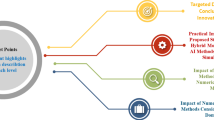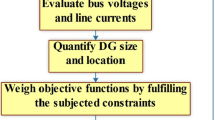Abstract
The continuous proliferation of distributed generation is leading end users to look for new tools that help to design hybrid electrical energy systems (HEES). Thus, this work proposes a novel approach for optimal planning of HEES, which comprises the optimization of the type and capacity of distributed generation connected to the end user. The main objective is to minimize the project’s total cost, considering the net metering scheme. To this end, the bioinspired meta-heuristic artificial immune system is proposed to optimally determine the number and type of photovoltaic panels. In addition, a nonlinear programming model is proposed to optimize the diesel generator and BESS capacity, considering the energy supply to the consumer by the HEES and the main distribution grid. Case studies involving commercial and residential customers in Brazil are introduced considering the normative resolutions from ANEEL, the Brazilian Regulatory Agency. Comparative analyses are made concerning an exhaustive search procedure and the commercial software Homer Pro, designed to optimize the operation of HEES systems. An important conclusion is that the proposed approach is as effective as the cutting-edge tools, with reasonable computational effort.





Similar content being viewed by others
Notes
State value-added tax on sales and services (ICMS) on semi-finished products.
Contribution to the Social Integration Plan.
Contribution for Social Security Financing.
Abbreviations
- k :
-
Type of PV panel
- max:
-
Maximum limit
- a :
-
Ambient
- Be:
-
Battery energy storage system
- ch:
-
BESS charging
- dg:
-
Diesel generator
- disch:
-
BESS discharging
- ins:
-
Instantaneous
- inv:
-
Inverter
- mod:
-
Module
- op:
-
Off-peak load period
- pe:
-
Peak load period
- pv:
-
Photovoltaic
- ref:
-
Reference
- sim:
-
Simulation
- u :
-
Period
- x :
-
Period related to the Brazilian tariff scheme
- \(P_{\text{re,u}}\) :
-
Power flow from the main grid to HEES
- \(x_k\) :
-
Defines what PV panel type has been chosen
- A :
-
Area
- Cc:
-
Cost of connecting cables, support structures and protection devices
- CC:
-
Fuel cost
- CCE:
-
Energy consumption cost
- CE:
-
Energy consumption proposed by HEES
- CI:
-
Initial investment cost
- CO:
-
Maintenance cost
- CP:
-
Total cost of PV panels
- Ct:
-
Cost of transportation and installation
- CV:
-
Energy provided to the main grid
- CVE:
-
Energy “sale” cost
- \(E_{\text{be}}\) :
-
BESS capacity
- FC:
-
Fuel consumption function
- N :
-
Number of energy sources
- TC:
-
Total cost
- \({\text{OBF}}\) :
-
Objective function
- P :
-
Power;
- SOC:
-
State of charge
- t :
-
Time
- \(z_{\text{be}}\) :
-
Binary variable that prevents the battery from charging and discharging simultaneously
- \(A_{\text{d}}\) :
-
Coefficient of consumption function
- \(B_{\text{d}}\) :
-
Coefficient of consumption function
- \(T_{\text{u}}\) :
-
Number of hours of the period u
- \({\text{ud}}_{\text{op}}\) :
-
Cost for the contracted demand at off-peak load periods
- \({\text{ud}}_{\text{pe}}\) :
-
Cost for the contracted demand at peak load periods
- Au:
-
Module area
- Cb:
-
Price term related to the Brazilian
- CD :
-
Cost for the contracted demand;
- cdf:
-
Charging/discharging factor
- D :
-
Contracted load demand
- fp:
-
Power factor
- ie:
-
Annual energy readjustment rate
- Im:
-
Nominal current capacity of the general protection device
- ip:
-
Annual inflation rate
- na:
-
Number of years of the planning horizon
- nf:
-
Number of phases
- NK:
-
Number of candidate types of PV panels
- \(N_{\text{pv,k}}^{\text{max}}\) :
-
Maximum number of type-k PV panels
- NU:
-
Number of periods;
- pc, pm, pr:
-
Parameters that control the cloning, somatic hypermutation and receptor editing mechanisms of the AIS algorithm;
- \({p}_{x}\) :
-
Probability occurrence of each tariff flag;
- PD:
-
Demand
- Pp:
-
Nominal power of photovoltaic panel unit
- Rad:
-
Radiation
- \({{\text{SOCf}}}^{\text{max}}\) :
-
Maximum SOC factor
- \({{\text{SOCf}}}^{\text{min}}\) :
-
Minimum SOC factor
- T :
-
Temperature;
- uc:
-
Unit cost
- UO:
-
Off-peak load period
- UP:
-
Peak load period
- Vn:
-
Nominal voltage of the installation
- α :
-
Capacity cost;
- β :
-
Temperature coefficient;
- η :
-
Efficiency
- \( \eta _{{{\text{be,rt}}}} \) :
-
BEES round-trip efficiency
References
Bignucolo F, Caldon R, Prandoni V (2008) Radial mv networks voltage regulation with distribution management system coordinated controller. Electric Power Syst Res 78:634–645
Strnad I, Prenc R (2018) Optimal sizing of renewable sources and energy storage in low-carbon microgrid nodes. Electr Eng 100:1661–1674
Chiradeja P, Ramakumar R (2004) An approach to quantify the technical benefits of distributed generation. IEEE Trans Energy Convers 19:764–773
Agência Nacional de Energia Elétrica. https://www.aneel.gov.br/. Accessed 21 July 2020
EURELETRIC. Prosumers: an integral part of the power system and the market. https://www.eurelectric.org/media/1945/prosumers_an_integral_part_of_the_power_system_and_market_june_2015-2015-2110-0004-01-e.pdf
Askarzadeh A (2017) Distribution generation by photovoltaic and diesel generator systems: energy management and size optimization by a new approach for a stand-alone application. Energy 122:542–551
D’Arco S, Suul JA, Fosso OBA (2015) Virtual synchronous machine implementation for distributed control of power converters in smartgrids. Electric Power Syst Res 122:180–197
Alqunun K, Guesmi T, Farah A (2020) Load shedding optimization for economic operation, cost in a microgrid. Electr Eng 102:779–791
Ramli MAM, Bouchekara HREH, Alghamdi AS (2018) Optimal sizing of PV/wind/diesel hybrid microgrid system using multi-objective self-adaptive differential evolution algorithm. Renew Energy 121:400–411
Muh E, Tabet F (2019) Comparative analysis of hybrid renewable energy systems for off-grid applications in Southern Cameroons. Renew Energy 135:41–54
Nadjemi O, Nacer T, Hamidat A, Salhi H (2017) Optimal hybrid PV/wind energy system sizing: application of cuckoo search algorithm for Algerian dairy farms. Renew Sustain Energy Rev 70:1352–1365
Hossain M, Mekhilef S, Olatomiwa L (2017) Performance evaluation of a stand-alone PV-wind-diesel-battery hybrid system feasible for a large resort center in South China Sea, Malaysia. Sustain Urban Areas 28:358–366
Singh S, Kaushik SC (2016) Optimal sizing of grid integrated hybrid PV-biomass energy system using artificial bee colony algorithm. IET Renew Power Gener 10:642–650
Razali NM, Hashim A (2010). Backward reduction application for minimizing wind power scenarios in stochastic programming. In: Power engineering and optimization conference (PEOCO), 2010. IEEE, pp 430–434
Singh A, Baredar P, Gupta B (2015) Computational simulation and optimization of a solar, fuel cell and biomass hybrid energy system using homer pro software. Procedia Eng 127:743–750
Miao C, Teng K, Wang Y, Jiang L (2020) Technoeconomic analysis on a hybrid power system for the UK household using renewable energy: a case study. Energies 13:3231–3249
Ayop R, Isa NM, Tan CW (2018) Components sizing of photovoltaic stand-alone system based on loss of power supply probability. Renew Sustain Energy Rev 81:2731–2743
Nordin ND, Rahman HA (2015) Pre-installation design simulation tool for grid-connected photovoltaic system using iterative methods. Energy Procedia 68:68–76
Borowy BS, Salameh ZM (1996) Methodology for optimally sizing the combination of a battery bank and PV array in a wind/PV hybrid system. IEEE Trans Energy Convers 11:367–375
Gözel T, Hocaoglu MH (2009) An analytical method for the sizing and siting of distributed generators in radial systems. Electric Power Syst Res 79:912–918
Ming M, Wang R, Zha Y, Zhang T (2017) Multi-objective optimization of hybrid renewable energy system using an enhanced multi-objective evolutionary algorithm. Energies 10:674–688
Castro RCC (2019) Hybrid particle swarm optimization and gravitational search algorithm for optimal sizing of hybrid renewable energy systems. In: Asia-Pacific power and energy engineering conference (APPEEC), 2019. IEEE, pp 1–6
Yang Y, Li R (2020) Techno-economic optimization of an off-grid solar/wind/battery hybrid system with a novel multi-objective differential evolution algorithm. Energies 13:1585–1600
Rousis AO, Konstantelos I, Strbac G (2019) A planning model for a hybrid AC–DC microgrid using a novel GA/AC OPF algorithm. IEEE Trans Power Syst 35:227–237
Ekren O, Ekren BY (2010) Size optimization of a pv/wind hybrid energy conversion system with battery storage using simulated annealing. Appl Energy 87:592–598
Mohamed S, Shaaban MF, Ismail M, Serpedin E, Qaraqe KA (2019) An efficient planning algorithm for hybrid remote microgrids. IEEE Trans Sustain Energy 10:257–267
Shivaie M, Mokhayeri M, Kiani-Moghaddam M, Ashouri-Zadeh A (2019) A reliability-constrained cost-effective model for optimal sizing of an autonomous hybrid solar/wind/diesel/battery energy system by a modified discrete bat search algorithm. Sol Energy 189:344–356
Bukar AL, Tan CW, Lau KY (2019) Optimal sizing of an autonomous photovoltaic/wind/battery/diesel generator microgrid using grasshopper optimization algorithm. Sol Energy 188:685–696
Kaabeche A, Diaf S, Ibtiouen R (2017) Firefly inspired algorithm for optimal sizing of renewable hybrid system considering reliability criteria. Sol Energy 155:727–738
Mellit A, Kalogirou SA, Drif M (2010) Application of neural networks and genetic algorithms for sizing of photovoltaic systems. Renew Energy 35:2881–2893
Margeta J, Glasnovic Z (2010) Feasibility of the green energy production by hybrid solar + hydro power system in europe and similar climate areas. Renew Sustain Energy Rev 2010(14):1580–1590
Homer Pro. https://www.homerenergy.com/products/pro/index.html. Accessed 08 Mar 2021
CRESEB C (2014) Manual de engenharia para sistemas fotovoltaicos. Rio de Janeiro, Brasil
Diaf S, Diaf D, Belhamel M, Haddadi M, Louche A (2007) A methodology for optimal sizing of autonomous hybrid PV/wind system. Energy Policy 35:5708–5718
Cummins Brasil. https://www.cummins.com.br/. Accessed 21 July 2020
Dranka GS, Ferreira P (2020) Towards a smart grid power system in Brazil: challenges and opportunities. Energy Policy 136:111033
Karimi H, Bahmani R, Jadid S, Makui A (2021) Dynamic transactive energy in multi-microgrid systems considering independence performance index: a multi-objective optimization framework. Int J Electr Power Energy Syst 126:106563
Gurobi Optimization. https://www.gurobi.com/. Accessed 08 Mar 2021.
Castro LN, Zuben FJV (2002) Learning and optimization using the clonal selection principle. IEEE Trans Evol Comput 6(3):239–251
Castro LN, Zuben FJV (1999) Artificial immune systems: part I-basic theory and applications. Technical Report TR-DCA 01/99
Castro LN, Zuben FJV (2000) Artificial immune systems: part II—a survey of applications. Technical Report DCA-RT 02/00
Oliveira LW, Oliveira EJ, Gomes FV, Silva IC, Marcato AL, Resende PV (2014) Artificial immune systems applied to the reconfiguration of electrical power distribution networks for energy loss minimization. Int J Electr Power Energy Syst 56:64–74
Wakui T, Hashiguchi M, Sawada K, Yokoyama R (2019) Two-stage design optimization based on artificial immune system and mixed-integer linear programming for energy supply networks. Energy 170:1228–1248
Neosolar. https://www.neosolar.com.br/loja/. Accessed 21 July 2020
INMETRO. https://www4.inmetro.gov.br/. Accessed 21 July 2020
ABNT Catálogo. https://www.abntcatalogo.com.br/norma.aspx?ID=195959. Accessed 21 July 2020
Lu J, Wang W, Zhang Y, Cheng S (2017) Multi-objective optimal design of a stand-alone hybrid energy system using entropy weight method based on HOMER. Energies 10:1664
Instituto Brasileiro de Geografia e Estatística. https://www.ibge.gov.br/. Accessed 21 July 2020
Companhia Energética de Minas Gerais. http://www.cemig.com.br/pt-br/Paginas/default.aspx. Accessed 21 July 2020
Instituto Nacional de Metereologia. http://www.inmet.gov.br/portal/. Accessed 21 July 2020
Pyomo. http://www.pyomo.org/. Accessed 08 Mar 2021
Acknowledgements
The authors would like to thank CNPq, FAPEMIG, CAPES e INERGE. In addition, this work is partially supported by the ERDF—European Regional Development Fund through the Operational Programme for Competitiveness and Internationalisation—COMPETE 2020 Programme, and by National Funds through the Portuguese funding agency, FCT—Fundação para a Ciência e a Tecnologia, within project ESGRIDS—Desenvolvimento Sustentável da Rede Elétrica Inteligente/SAICTPAC/0004/2015—POCI-01-0145-FEDER-016434.
Author information
Authors and Affiliations
Corresponding author
Additional information
Publisher's Note
Springer Nature remains neutral with regard to jurisdictional claims in published maps and institutional affiliations.
Rights and permissions
About this article
Cite this article
Kitamura, D.T., Rocha, K.P., Oliveira, L.W. et al. Optimization approach for planning hybrid electrical energy system: a Brazilian case. Electr Eng 104, 587–601 (2022). https://doi.org/10.1007/s00202-021-01316-3
Received:
Accepted:
Published:
Issue Date:
DOI: https://doi.org/10.1007/s00202-021-01316-3




